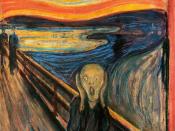AbstractThe paper summarizes a single-system design aimed at improving the participant's score on the Clinical Assessment of Anxiety through the intervention of meditative breathing. A baseline of three weeks was measured followed by four weeks of treatment phase. During the treatment phase, the participant completed meditative breathing exercise three times daily for five days each week. The participant completed the Clinical Assessment of Anxiety each Friday of the treatment phase. The results indicated improvement in the scores, however the participant's score never got below the clinical cutting score of 30.
Meditative Breathing for the Treatment of AnxietyThe purpose of this paper is to present the findings from an experiment that examined the effectiveness of meditative breathing on the participant's clinical level of anxiety.
AnxietyMood and anxiety disorders are among the most common psychiatric disorders noted in the clinical setting. About 5% of U.S. adults experience generalized anxiety disorder at some point during their lifetime, and about 3% have it in any given year (Toneatto & Nguyen, 2007).
Some ways anxiety manifests in persons who suffer from it are gastrointestinal symptoms, sleep disturbances, changes in eating patterns, muscle aches and pains, increased irritability, shortness of breath, and difficulty concentrating (Zinn et al., 1992). Another common symptom of anxiety is racing thoughts, which often stems from difficulty concentrating. A person with a clinically high level of anxiety may not be able to maintain focus on a present task due to his or her fleeting thoughts of future responsibilities needing attention.
Studies have shown that there is a genetic component in persons who are diagnosed with anxiety disorders; however, research also strongly suggests that a person's environment, particularly a consistently stressful one, can influence his or her anxiety level in a negative way (Zinn et al., 1992).
With the increased frequency anxiety...


